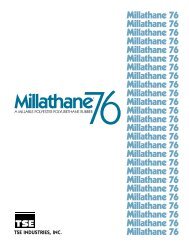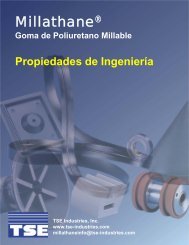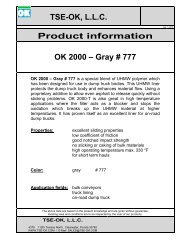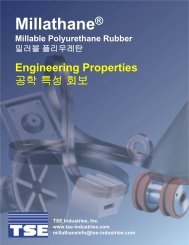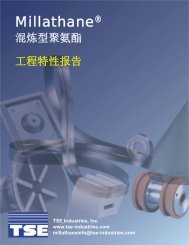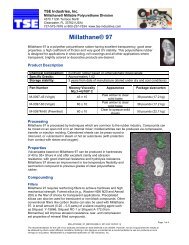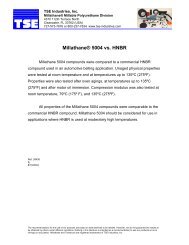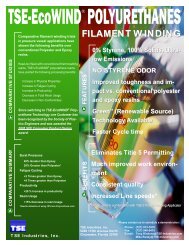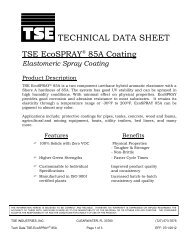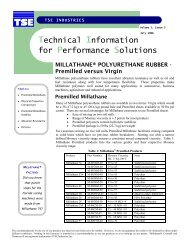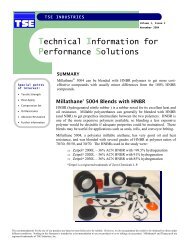Choosing the Right Millathane® Polyester Urethane - TSE Industries ...
Choosing the Right Millathane® Polyester Urethane - TSE Industries ...
Choosing the Right Millathane® Polyester Urethane - TSE Industries ...
Create successful ePaper yourself
Turn your PDF publications into a flip-book with our unique Google optimized e-Paper software.
<strong>TSE</strong> INDUSTRIES<br />
Volume 3, Issue 5<br />
December 2006<br />
Technical Information<br />
for Performance Solutions<br />
<strong>Choosing</strong> <strong>the</strong> <strong>Right</strong> MILLATHANE® <strong>Polyester</strong><br />
<strong>Urethane</strong><br />
Topics:<br />
• Grades Evaluated<br />
• Typical Applications<br />
• Formulation<br />
• Physical Properties<br />
• Heat Aging<br />
• Fluid Aging<br />
• O<strong>the</strong>r Tests<br />
• Effect of Peroxide<br />
Level<br />
<strong>TSE</strong> <strong>Industries</strong> currently provides five grades of polyester millable polyurethanes, each being<br />
developed for different end use applications. This study compares <strong>the</strong>se five polyester millable<br />
urethanes to better assist <strong>the</strong> compounder in choosing <strong>the</strong> best millable urethane having <strong>the</strong> required<br />
properties for <strong>the</strong> application.<br />
Grades Evaluated<br />
Millathane 76 – General purpose, sulfur and peroxide curable<br />
Millathane 5004 – Excellent heat and oil resistance; peroxide curable only<br />
Millathane 66 – Excellent processing, heat and oil resistance; peroxide curable only<br />
Millathane HT – Excellent hydrolytic stability and low temperature flexibility; sulfur and<br />
peroxide curable<br />
Millathane 28 – Excellent resistance to gas permeability combined with low temperature<br />
flexibility; peroxide curable only<br />
Typical Applications<br />
Millathane 76 is used in automotive vibration damping applications such as door and trunk stoppers<br />
because of its low resilience and consistent modulus upon aging.<br />
Millathane 5004 has excellent tear strength which enables de-molding of parts having complex design<br />
with low scrap.<br />
Millathane 66 and Millathane HT are used in business machine applications where low temperature<br />
properties, combined with excellent abrasion resistance, are required for small rollers and drive belts.<br />
Millathane 28 offers excellent permeability resistance combined with low temperature properties for<br />
automotive and industrial pneumatic seals and gaskets.<br />
Formulation<br />
The same general formulation was used for all compounds, with <strong>the</strong> only variable being <strong>the</strong> peroxide<br />
(DiCup 40C) level, as each polymer requires different peroxide levels to achieve optimum properties.<br />
Two peroxide levels were evaluated for each polymer. The compounds with <strong>the</strong> peroxide level that<br />
gave similar stress at 100% elongation (100% modulus) are shown to compare <strong>the</strong> polymers on an<br />
equal basis. Data comparing <strong>the</strong> two peroxide levels is shown on page 3.<br />
Millathane® <strong>Urethane</strong> 100.0<br />
Stearic acid 0.2<br />
N330 Black 25.0<br />
DBEEA (TP-95) 2.0<br />
Struktol WB-222 1.0<br />
Stabaxol P 2.0<br />
DiCup 40C<br />
Variable<br />
The recommendations for <strong>the</strong> use of our products are based on tests believed to be reliable. However, we do not guarantee <strong>the</strong> results to be obtained by o<strong>the</strong>rs under<br />
different conditions. Nothing in this literature is intended as a recommendation to use our products so as to infringe on any patent. Millathane®, Crystal® and<br />
Thanecure® are registered trademarks of <strong>TSE</strong> <strong>Industries</strong>, Inc.
Page 2<br />
TIPS<br />
Physical Properties<br />
As <strong>the</strong> table below shows, Millathane 66 and Millathane 28 gave <strong>the</strong> highest tensile strength, while Millathane 5004 gave<br />
<strong>the</strong> highest tear strength.<br />
Millathane grade 76 5004 66 HT 28<br />
DiCup 40 level 2 4 6 1 6<br />
Hardness, Shore A 65 70 67 69 65<br />
<strong>TSE</strong>-100*, psi 310 390 300 270 300<br />
MPa 2.1 2.7 2.1 1.9 2.1<br />
<strong>TSE</strong>-300*, psi 1840 1770 1300 1430 1600<br />
MPa 12.7 12.2 9.0 9.9 11.0<br />
Tensile Strength, psi 3840 3910 4560 3260 4800<br />
MPa 26.5 27.0 31.4 22.5 33.1<br />
Elongation, % 465 565 625 485 570<br />
Tear, Die C, lb/in 199 304 258 172 250<br />
kN/m 34.8 53.2 45.2 30.1 43.8<br />
Heat Aging<br />
'*<strong>TSE</strong>xxx=Tensile Stress at xxx% Elongation<br />
Heat aging at both 100ºC and 125ºC showed very good results for all <strong>the</strong> compounds, with Millathane HT having<br />
somewhat higher change of elongation after aging than <strong>the</strong> o<strong>the</strong>r Millathane grades.<br />
Millathane grade 76 5004 66 HT 28<br />
DiCup 40 level 2 4 6 1 6<br />
Oven Aging 70 hr/100º C<br />
Hardness change, pts. 2 5 3 6 5<br />
Tensile strength change, % 10 11 7 3 -11<br />
Elongation change, % 1 -2 1 -16 4<br />
Oven Aging 70 hr/125º C<br />
Hardness change, pts. 4 3 5 3 1<br />
Tensile strength change, % -7 12 5 5 -1<br />
Elongation change, % -15 -12 -10 -38 -4<br />
Fluid Aging<br />
The IRM 903 oil aging showed good results for all <strong>the</strong> compounds, with Millathane 5004, 66, and 28 giving slightly better<br />
overall retention of properties. The boiling water immersion test showed <strong>the</strong> best retention of properties with Millathane<br />
HT, 66, and 5004. Note that all compounds had two parts of <strong>the</strong> hydrolysis stabilizer Stabaxol P added to <strong>the</strong> formulations.<br />
The toluene immersion test showed <strong>the</strong> best resistance to swelling by Millathane 28, while Millathane 28, 76, and 5004<br />
had <strong>the</strong> lowest hardness changes.<br />
Millathane grade 76 5004 66 HT 28<br />
DiCup 40 level 2 4 6 1 6<br />
IRM 903 Oil aging, 70 hr/100º C<br />
Hardness change, pts. -7 -5 -7 -6 -8<br />
Tensile strength change, % -23 4 -9 -5 -1<br />
Elongation change, % -13 -5 -6 -30 -3<br />
Water aging 70 hr/100º C<br />
Hardness change, pts. -15 -8 -9 -4 -8<br />
Tensile strength change, % -42 -19 -26 -17 -44<br />
Elongation change, % 39 19 1 -25 9<br />
Volume change, % 7 2 3 2 4<br />
Toluene aging, 7 days/23ºC<br />
Hardness change, pts. -13 -13 -20 -20 -15<br />
Volume change, % 58 61 61 60 48
TIPS<br />
Page 3<br />
O<strong>the</strong>r Tests<br />
Compounds based upon Millathane 76 and HT gave lower resilience (rebound) than <strong>the</strong> o<strong>the</strong>r polyester urethanes.<br />
Millathane 5004, 28 and 66 had <strong>the</strong> best abrasion resistance, while Millathane HT, 66, and 5004 had <strong>the</strong> lowest brittle point.<br />
Compression set resistance was best for Millathane 28, 76, and 66.<br />
Millathane grade 76 5004 66 HT 28<br />
DiCup 40 level 2 4 6 1 6<br />
Bashore Resilience, %<br />
25 43 50 23 44<br />
DIN Abrasion, mm³ 115 70 55 86 66<br />
Low Temperature Brittle Point, ºC -35 -55 -57 -59 -45<br />
Compression Set, %<br />
22 hr/70ºC 7 13 11 10 7<br />
22 hr/100ºC 24 40 24 35 24<br />
22 hr/125ºC 39 67 39 52 33<br />
Effect of Peroxide Level<br />
Generally, higher peroxide levels give higher stress at elongation (modulus) values, better abrasion resistance, lower<br />
compression set, and better fluid resistance. The charts below illustrate <strong>the</strong> effect of peroxide level on several of <strong>the</strong>se<br />
properties.<br />
Compression Set, 22 hr/100ºC<br />
DIN Abrasion (ASTM D5963)<br />
70<br />
160<br />
60<br />
140<br />
50<br />
120<br />
Set, %<br />
40<br />
30<br />
mm³ loss<br />
100<br />
80<br />
60<br />
20<br />
40<br />
10<br />
20<br />
0<br />
76-2 76-3 5004-4 5004-5 66-5 66-6 HT-0.5 HT-1 28-5 28-6<br />
Millathane® grade - DiCup 40 level<br />
0<br />
76-2 76-3 5004-4 5004-5 66-5 66-6 HT-0.5 HT-1 28-5 28-6<br />
Millathane® grade - DiCup 40 level<br />
IRM 903 Oil Immersion, 70 hr/100º C<br />
Volume change<br />
Toluene Immersion, 7 days/23ºC<br />
Volume change<br />
10.0<br />
200<br />
180<br />
8.0<br />
160<br />
Volume change, %<br />
6.0<br />
4.0<br />
2.0<br />
Volume change, %<br />
140<br />
120<br />
100<br />
80<br />
60<br />
40<br />
0.0<br />
-2.0<br />
76-2 76-3 5004-4 5004-5 66-5 66-6 HT-0.5 HT-1 28-5 28-6<br />
20<br />
0<br />
76-2 76-3 5004-4 5004-5 66-5 66-6 HT-0.5 HT-1 28-5 28-6<br />
Millathane® grade - DiCup 40 level<br />
Millathane® grade - DiCup 40 level
TIPS<br />
<strong>TSE</strong> INDUSTRIES<br />
4370 112th Terrace North<br />
Clearwater, FL , USA 33762-4902<br />
Toll Free: 800-237-7634<br />
Phone: 727-573-7676<br />
Fax: 727-572-0487<br />
E-mail: millgumsinfo@tse-industries.com<br />
www.tse-industries.com<br />
We are here to serve you:<br />
Tom Jablonowski, Technical Service Manager tom.jablonowski@tse-industries.com<br />
Jim Ahnemiller, Technical Director<br />
jim.ahnemiller@tse-industries.com<br />
Nina Manee, Sales & Marketing Representative nina.manee@tse-industries.com<br />
Jerry McCall, Director of Sales & Marketing jerry.mccall@tse-industries.com<br />
Technology / Service /<br />
Experience<br />
An ISO 9001:2000<br />
Certified Company<br />
SUMMARY<br />
The five polyester millable urethanes tested in this report have somewhat different chemical compositions<br />
which give <strong>the</strong>m different properties in vulcanized compounds. It is important to choose <strong>the</strong> best polymer<br />
for <strong>the</strong> properties required in <strong>the</strong> finished part. Some polyester urethanes are better for oil resistance or<br />
abrasion resistance, for example, than o<strong>the</strong>rs, and <strong>the</strong> state of cure (here studied by two levels of peroxide)<br />
can affect most of <strong>the</strong>se properties as well. Hopefully, this study will be useful in choosing <strong>the</strong> best<br />
Millathane millable urethane for <strong>the</strong> job.<br />
Note: Additional test results are available in <strong>the</strong> full report XP-4642. Contact us to obtain a copy.



